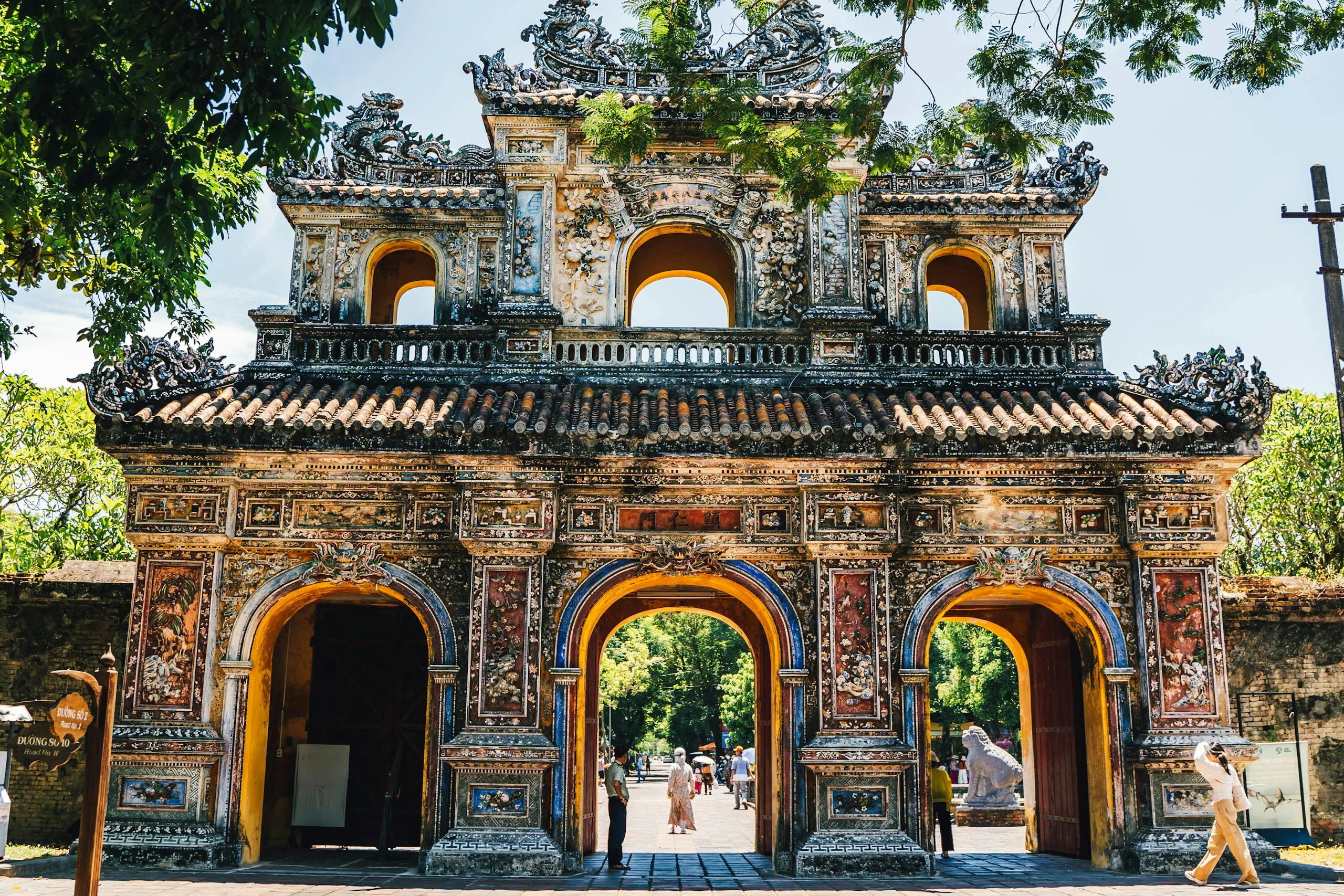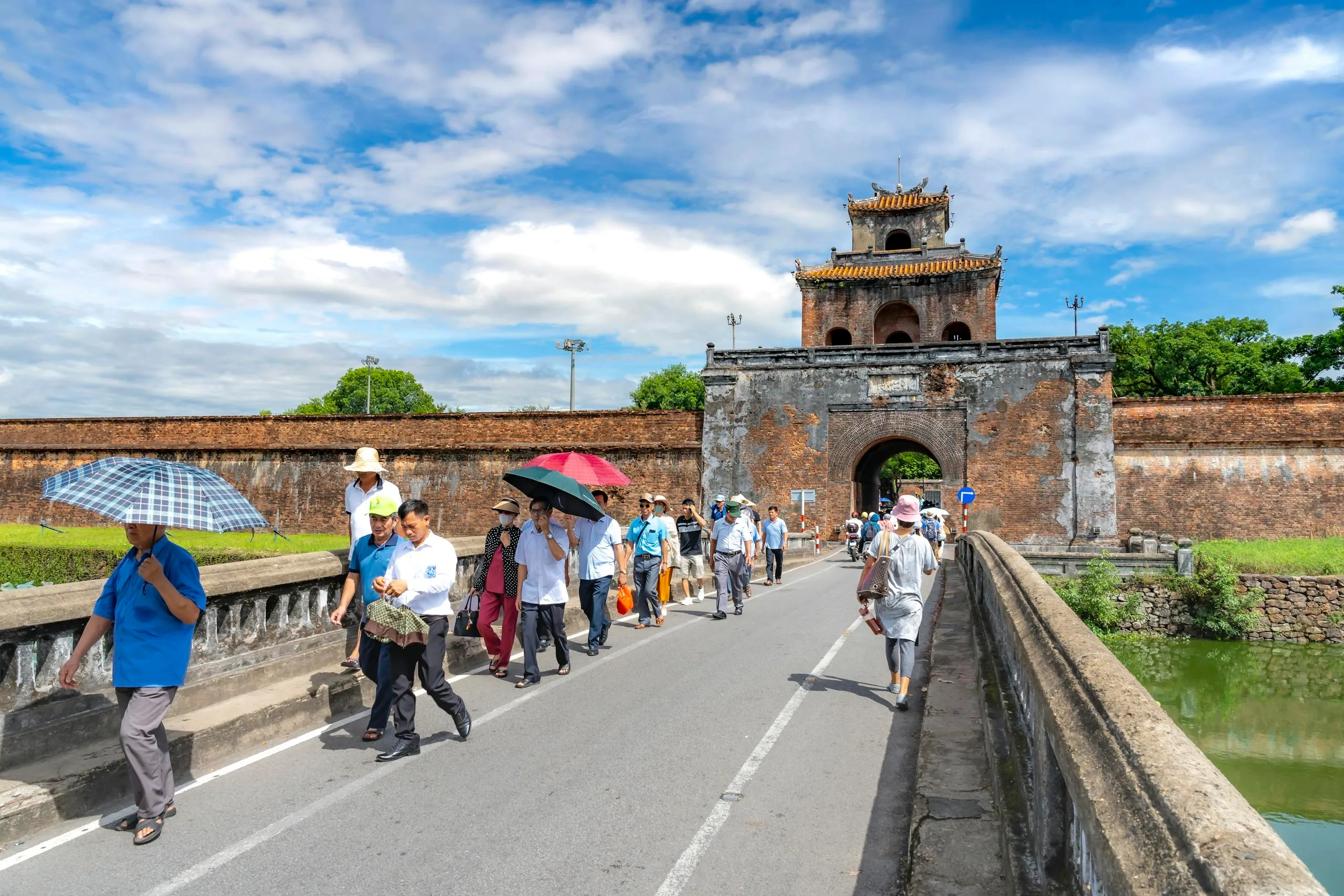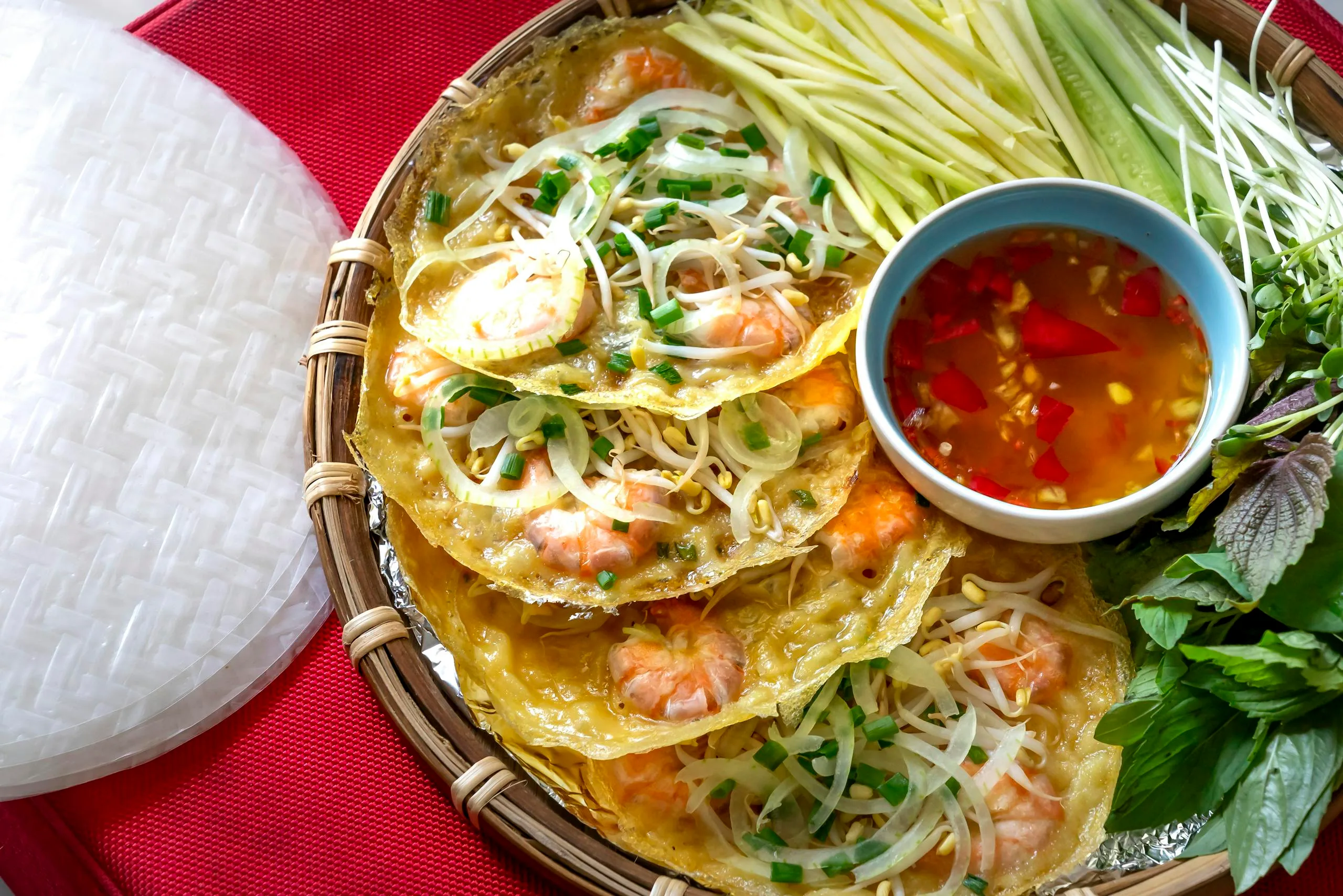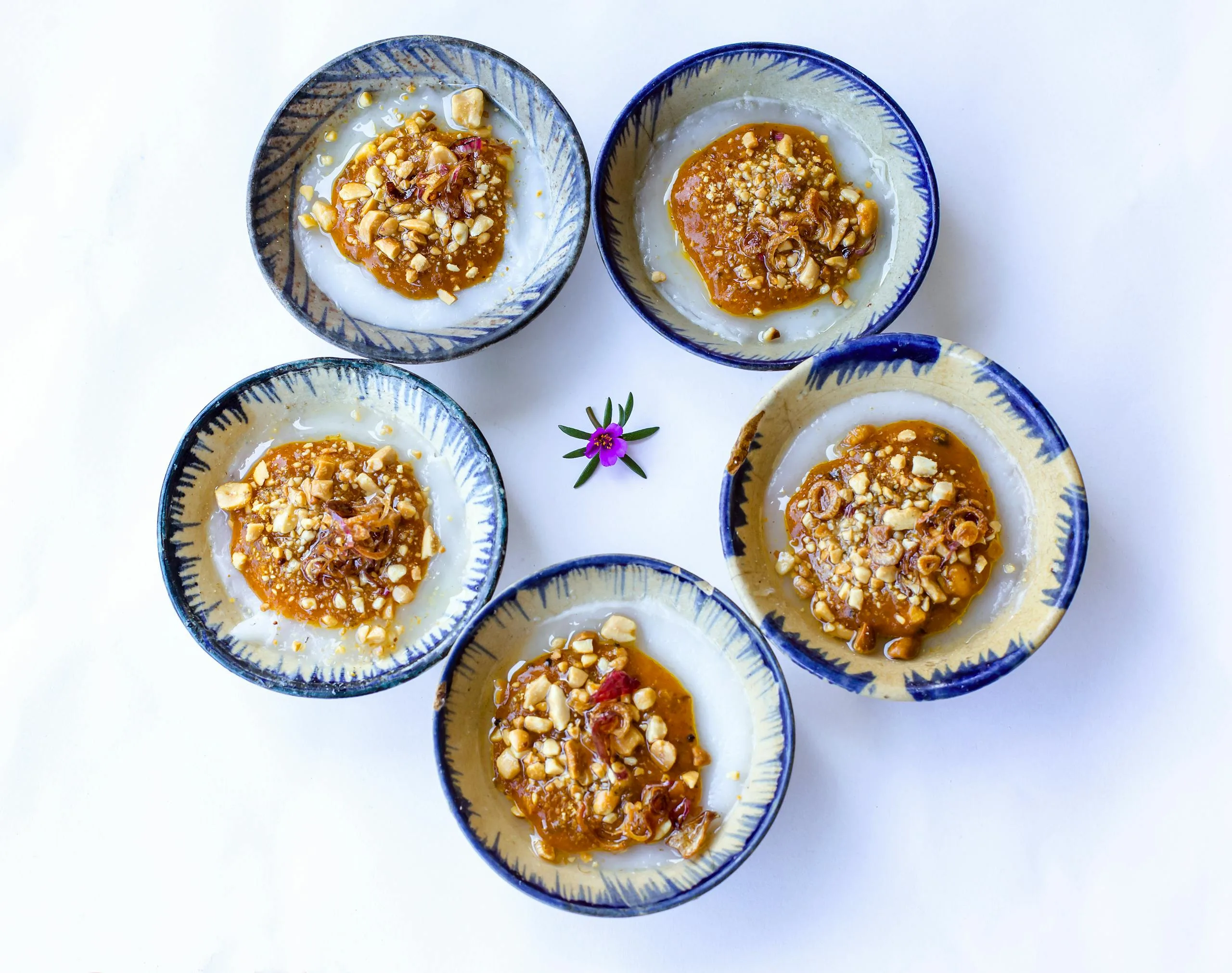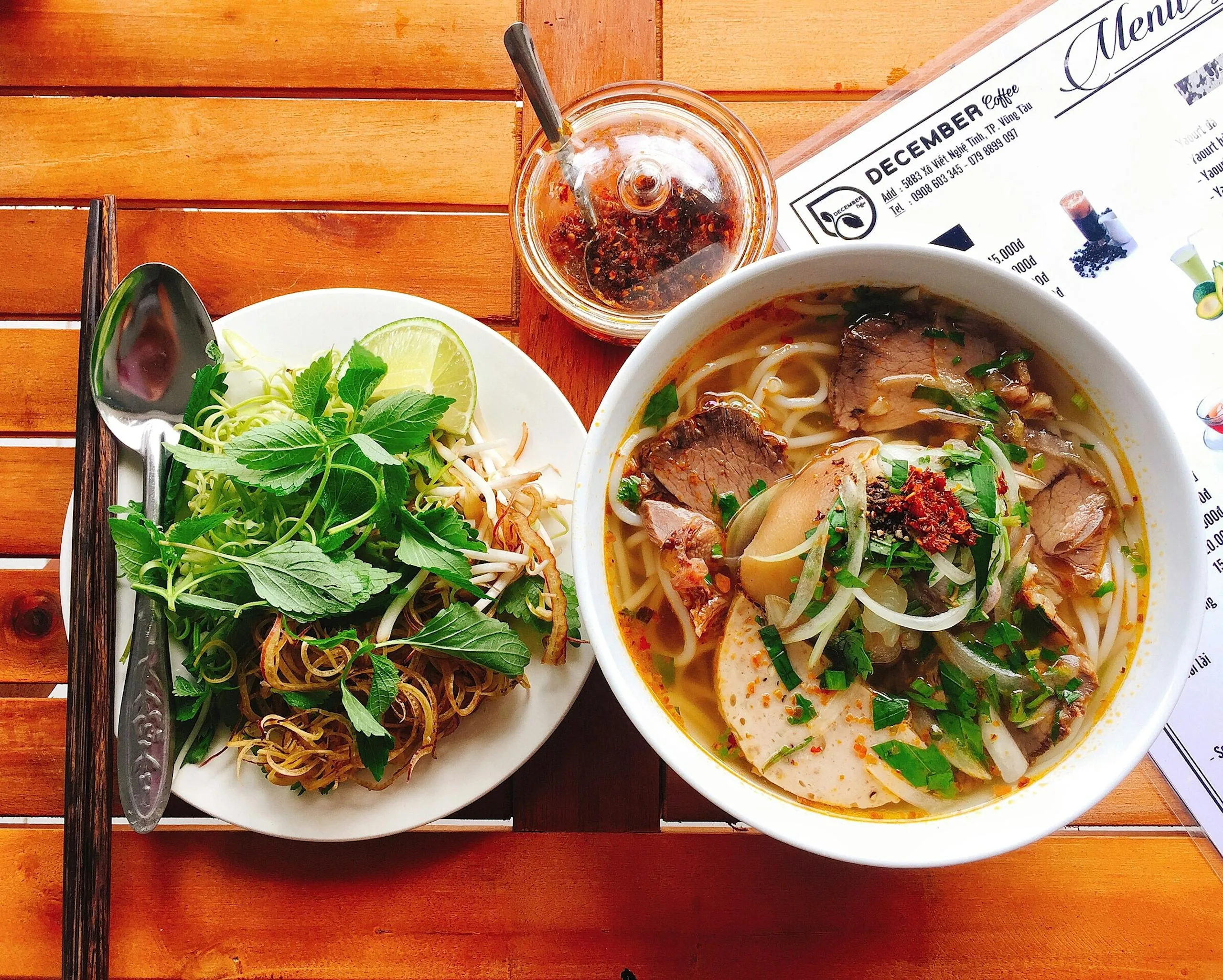Blog » Travel Guides » Immersive Cultural ...
Immersive Cultural Experiences and Royal Cuisine in Hue: A Traveler’s Guide 2025
Discover the rich imperial heritage of Hue through its royal cuisine, traditional craft villages, iconic landmarks, and vibrant cultural festivals. This guide provides practical tips, insider insights, and curated experiences for travelers seeking an authentic and immersive visit to Hue in 2025.
Key Takeaways
- Hue’s Imperial City is a UNESCO World Heritage Site featuring the Citadel, Imperial City, and Forbidden Purple City, offering rich insights into Vietnam’s Nguyen Dynasty.
- Hue’s royal cuisine blends artistic presentation and Yin-Yang harmony, with dishes like Nem Công Chả Phượng and Bún bò Huế best sampled at traditional restaurants and street markets.
- Traditional craft villages around Hue provide hands-on workshops in paper flower making, incense rolling, bamboo weaving, and pottery, allowing immersive cultural experiences.
- The Perfume River offers scenic boat tours and sunset cruises that connect key historical sites and include cultural performances such as traditional music and lantern festivals.
- Hue’s major festivals, especially the biennial Hue Festival and the Ao Dai Week, feature royal court music, dances, artisan workshops, and parades, inviting visitors to actively participate.
- Visitors are encouraged to use local transport like cyclos and motorbikes, join guided tours for deeper understanding, and respect local customs for an authentic Hue experience.
Get ready to dive into the heart of Vietnam with some truly amazing cultural experiences in Hue.
This city is packed with imperial history and bursting with vibrant traditions.
Whether you’re wandering through the grand Imperial City and exploring royal tombs, tasting royal dishes that once belonged only to emperors, or soaking up the lively festival vibes, Hue is like stepping right into a living storybook.
This guide is here to show you all the must-see spots—from iconic landmarks to charming craft villages where you can try your hand at traditional arts, plus scenic adventures along the Perfume River.
You’ll also find handy tips on local customs, how to get around, and the best ways to see the city like a local. Prepare yourself for a rich and hands-on experience filled with history, flavors, and culture that really comes to life.
Exploring Hue’s Imperial Heritage

Overview of Hue’s Imperial City and Landmarks
Hue’s Imperial City is truly a highlight—a UNESCO World Heritage Site that stands as a stunning testament to Vietnam’s imperial legacy.
Built by the Nguyen Dynasty in the early 1800s, the whole complex includes the Citadel, the Imperial City, and the Forbidden Purple City. Each part unpacks a bit of political, ceremonial, and spiritual life from a long-gone era.
When you walk around, you’ll see imposing walls, traditional palaces, peaceful gardens, and sacred temples that all scream majesty and history.1
- The Citadel is a giant walled fortress with a moat, roughly 2 km on each side, designed to impress and protect.
- The Imperial City (Hoang Thanh) was the heart of power—home to royal residences, ancestor temples, and beautifully designed gardens.
- Forbidden Purple City (Tu Cam Thanh) was the emperor’s private sanctuary, with ornate palaces like Can Chanh and the Royal Theatre for court performances.
- Key spots to check out include the grand Ngo Mon Gate (also called Bangor Gate), the Thai Hoa Palace where important receptions were held, and the elegant Hien Lam pavilion.
Visiting the Imperial City: Tickets, Hours, and Tips
You’ll need a ticket to wander through big parts of the Imperial City, including spots like Ngo Mon Gate and the Forbidden Purple City. It’s open daily, but the hours change a bit with the seasons:
- Summer (April to September): 7:00 AM – 5:30 PM
- Winter (October to March): 7:30 AM – 5:00 PM
Here are some neat tips to make your visit better:
- Get there early to beat the crowds and the midday heat—plus, it’s the best time for photos and peaceful wandering.
- Give yourself at least half a day—this place is huge, over 500 hectares full of history.
- Consider joining a guided tour or picking up a detailed map so the stories behind the walls aren’t lost on you.
- Don’t miss the Changing of the Guards, which happens every day at 8:30 AM at the main gate—a cool peek into royal tradition.
Must-See Royal Tombs and Mausoleums
Outside the Imperial City, several royal tombs along the picturesque Perfume River add to Hue’s imperial charm. These mausoleums mix peaceful landscapes with intricate architecture:
- Minh Mang Tomb: Known for its perfect harmony between architecture and nature, combining symmetry with lush surroundings.
- Khai Dinh Tomb: Famous for mixing European and Vietnamese-style mosaics, it’s a masterpiece of detailed craftsmanship.
- Tu Duc Tomb: A serene getaway with beautiful gardens, elegant pavilions, and poetic lakes—reflecting the refined tastes of Emperor Tu Duc.
Architecture and Storytelling in Imperial Sites
The whole imperial complex was carefully designed following Feng Shui principles to highlight imperial power and spiritual balance. The architecture here is a fascinating blend of Vietnamese traditions, Chinese influences (especially from Beijing’s Forbidden City), and a touch of French colonial style.1
Look closely at the carvings, stonework, and royal art inside the palaces and temples—they tell stories about court life, ceremonies, and governance in the Nguyen era. Places like Thai Hoa Palace and Ngo Mon Gate aren’t just old buildings—they’re cultural icons where history feels alive.
Savoring Royal Cuisine and Traditional Foods

Historical Roots of Hue’s Royal Cuisine
Hue’s royal cuisine was born inside the Nguyen court (1802–1945), where chefs didn’t just whip up tasty meals—they created edible works of art based on Yin-Yang harmony. Every dish balanced flavors, colors, and presentation, often decorated with dragon, phoenix, or peacock motifs representing royalty and good luck.135
Top Royal Dishes to Try and Where to Find Them
Don’t leave Hue without trying these royal classics:
- Nem Công Chả Phượng: Beautifully made spring rolls shaped like phoenixes and peacocks, delicate and tasty.
- Bánh bèo, Bánh nậm, Bánh lọc: A trio of steamed rice cakes with shrimp or pork—small, flavorful, and addictive.
- Chè Huế: Local sweet soups and puddings that make perfect desserts.
- Cơm Vua (King’s Rice): A royal meal with lots of small side dishes, showing off imperial dining style.
- Bún bò Huế: The famous spicy beef noodle soup that started here and is still a local favorite.
- Nem rán cung đình: Imperial spring rolls with special ingredients and complex techniques.
Where to eat: For fancy royal meals, check out places like Y Thao Garden and Nhà Hàng Cung Đình —they serve authentic royal fare in beautiful, historic settings.
If you want something casual and buzzing, the street food stalls and markets around Dong Ba Market are perfect for traditional snacks and rice cakes.124
Unique Dining Experiences in Hue’s Cultural Context
Eating in Hue is more than just food—it’s a cultural experience. Try these if you get the chance:
- Garden House Dining: Enjoy royal dishes in tranquil garden homes, with traditional music setting the mood.
- Food Tours: Explore everything from fancy royal banquets to lively street food stalls, blending high culture and everyday eats.
- Colonial Villa Meals: Historic villas outside the city mix French and Vietnamese imperial flavors.
- Cyclo and Motorbike Tours: Glide through the city’s street food scene on a cyclo or motorbike tour to find hidden gems.
Tips for Enjoying Local Food Markets and Street Eats
Want to dive into Hue’s street food scene? Here’s some quick advice:
- Carry cash: Many small vendors don’t take cards.
- Try everything: Don’t skip local favorites like bánh bèo, bánh khoái (crispy pancakes), and bún bò Huế.
- Go where locals go: Busy stalls usually mean fresh and tasty food.
- Pair meals with local drinks: Give nước mía (sugarcane juice) or traditional teas a whirl—they’re refreshing!
- Check hygiene: Pick spots with clean prep areas and lots of customers.
- Ask around: Locals and vendors are usually happy to point you toward the best bites.
- Order small portions: The dishes come in modest sizes so you can sample lots.
| Dish | Description | Where to Try |
|---|---|---|
| Nem Công Chả Phượng | Royal-style spring rolls with artistic presentations | High-end restaurants, royal banquets |
| Cơm hấp lá sen | Rice steamed in lotus leaf, fragrant and delicate | Fine-dining spots, select local eateries |
| Bánh bèo | Steamed rice cakes topped with shrimp or pork | Street stalls, Dong Ba Market |
| Bánh lọc | Shrimp and pork dumplings wrapped in tapioca | Local vendors, casual restaurants |
| Chè Huế | Variety of sweet soups and puddings | Local dessert shops, markets |
| Bún bò Huế | Spicy beef noodle soup | Noodle shops, street markets |
Hue’s food scene perfectly blends imperial refinement with vibrant Central Vietnamese flavors. Whether you’re sitting in a lush garden house or amidst the buzz of a street market, every bite tells a story of heritage and culture.12345
Traditional Craft Villages: Hands-On Cultural Immersion

Introduction to Hue’s Most Renowned Craft Villages
Hue’s traditional craft villages are alive with artisans keeping centuries-old skills alive. These places give you a cool chance to watch, learn, and even try creating authentic Vietnamese crafts. Check out places like:
- Thanh Tien Paper Flower Village: Famous for colorful paper flowers used in ceremonies and festivals.
- Thuy Xuan Incense Village: Where hand-rolled incense sticks, important for spiritual rituals, are made with care.
- Phu Cam Non La (Conical Hat) Village: See bao la hats being skillfully woven, and maybe try weaving yourself.
- Bao La Bamboo Weaving Village: Experts at making baskets, sieves, and other neat bamboo goods.
- Phuoc Tich Ceramic Village: With 500 years of tradition, its beautiful ceramics once graced royal tables.
Artisan Skills and Techniques to Experience
Many villages offer workshops where you can roll incense sticks, shape pottery, weave bamboo, or make paper flowers. These hands-on sessions often come with stories about the crafts—and some tours mix in culinary crafts like making sesame candies and traditional cakes for a full-sensory cultural day.
Shopping for Authentic Handicrafts and Souvenirs
When buying souvenirs, go straight to the artisans or official village cooperatives to ensure what you get is the real deal. These pieces show unique hand-finished details reflecting the maker’s style and tradition. Don’t be shy to ask about the craft’s background or even check authenticity certificates. Visiting during local festivals is extra special—you might meet craftspeople and find limited-edition items.
Practical Information: Access, Entry Costs, and Tours
Most of these villages are 10 to 30 km from central Hue and easy to reach by motorbike, car, or organized tours. Usually, there’s no entry fee, though workshops might cost a little, often included in tour packages. Tours can be group or private, featuring transport, English-speaking guides, craft lessons, and snacks. Just remember to bring sun protection and comfy shoes.
- Top Villages: Thanh Tien, Thuy Xuan, Phu Cam, Bao La, Phuoc Tich
- Activities: Flower making, incense rolling, bamboo weaving, pottery shaping
- Tips: Buy direct, check authenticity, learn about cultural meaning
- Plan: No usual entry fees, small workshop charges, tours recommended for context
Perfume River Activities and Scenic Boat Rides

Cultural Significance of the Perfume River
The Perfume River is basically the soul of Hue, winding through the city and connecting historic sites like beads on a string. It was once a vital route for transport, trade, and royal events. The name comes from fragrant flowers that used to float on its surface—a poetic image celebrated in art, music, and poetry.1
The river is still at the heart of local culture, hosting events like the Hue Festival, which lights up the water with boat parades, spiritual ceremonies, and performances.
Best Boat Tours to Experience Hue’s Heritage
Seeing Hue from the water is a whole different vibe. Dragon boat tours are super popular—they take you on relaxing rides stopping at spots like Thien Mu Pagoda, the Imperial City, and the Tomb of Emperor Tu Duc. These can be quick hour-long trips or full-day adventures, often with stories, local crafts demos, or fishing shows along the way.3
Book your ride through local operators or right at the docks. Just a heads-up—you’ll usually want to haggle a bit to get a good deal but make sure it’s safe and comfy.
Evening River Cruises and Local Entertainment
Sunsets on the Perfume River are something special. Evening cruises often come with tea or dinner, making for a peaceful end to your day. They get even more magical during lantern festivals, when the river sparkles with floating lanterns and lit-up landmarks.2
Many night tours include performances of ca Hue—a traditional local music style—that amps up the cultural vibe as you glide past softly glowing palaces and pagodas. It’s a perfect combo of nature, music, and history to soak in before bedtime.
| Activity | Highlights | Duration | Best Time |
|---|---|---|---|
| Dragon Boat Tours | Thien Mu Pagoda, Imperial City, Tomb of Tu Duc | 1 hour to full day | Daytime |
| Sunset Cruises | Scenic views, tea or dinner onboard | 1–2 hours | Evening |
| Lantern Festival Cruises | Floating lanterns, traditional music | Depends on event | Evening during festivals |
Festivals and Local Ceremonies: Engaging with Hue’s Living Traditions

Key Cultural Festivals and Their Historical Background
Hue Festival: This big event happens every two years in April and celebrates the city’s imperial past when it was the Nguyen dynasty’s capital until 1945. Imagine a full week of royal court music, traditional dances, calligraphy, kite flying, lively street parades, and fireworks—all set mostly inside the UNESCO-listed Imperial City and other historic spots. It’s like a vibrant time machine back to Vietnam’s regal days.134
Hue Community Ao Dai Week: In June, this festival spotlights Vietnam’s famous Ao Dai dress with exhibitions, artisan workshops, and fashion shows at places like An Dinh Palace. It shows off Hue as a hub for traditional dress and textile arts.5
Participating in Traditional Ceremonies
If you want to get really involved, there are plenty of opportunities—from temple rituals and imperial music/dance shows to interactive Ao Dai tailoring workshops. Plus, street parades, poetry sessions, craft markets, and river races invite visitors to join in, making the culture feel alive and welcoming.1235
Annual Event Calendar Highlights for 2025
| Festival / Event | Timing | Highlight Activities | Guest Participation Tips |
|---|---|---|---|
| Hue Festival | April (third lunar month) | Royal court music, dance, kite flying, fireworks, street parades | Book early, join open workshops, respect local customs |
| Hue Community Ao Dai Week | June 6–15 | Ao Dai exhibitions, artisan workshops, fashion shows | Interact with artisans, attend tailoring demos, explore historic sites |
Museums and Cultural Centers for Deepening Understanding

Top Museums Showcasing Hue’s Imperial Culture
Hue’s museums really bring its history to life. The Thua Thien Hue History Museum itself is the star attraction, with over 80 buildings spread across 500 hectares—including palaces, temples, and gardens from the Nguyen Dynasty. It’s more than just architecture: it hosts cultural events and exhibitions too.
Another gem is the Hue Museum of Royal Antiquities, located in the elegant Long An Palace. It’s the oldest museum in town and showcases royal garments, jewelry, porcelain, and seals that dive deep into imperial material culture. Open daily, admission fees help keep preservation going strong.
If you’re curious about more recent times, the Thua Thien Hue History Museum covers revolutionary history, anti-colonial resistance, and local heritage, giving context to the city’s 20th-century story.
Interactive Exhibits and Local Art Collections
Many museums in Hue have interactive displays to make history more engaging. The Royal Antiquities Museum often hosts guided tours and live craft demos, so you can connect closer with the artifacts. The Imperial City also comes alive with court music performances and art shows, making the royal past feel vibrant and real.
Visitor Tips and Entry Details
- Set aside a full day for the Imperial City—there’s a lot to explore.
- Wear comfy shoes and bring sun protection, since much sightseeing means being outdoors.
- Check opening hours and ticket prices before you go; some spots offer discounts for kids or free entry on special days.
- Buying tickets onsite is usually easiest. Try to visit during quieter times if you want to avoid crowds.
- Consider rounding out your visit with trips to nearby royal tombs and pagodas for a fuller cultural picture.
Practical Travel Tips for an Authentic Hue Experience
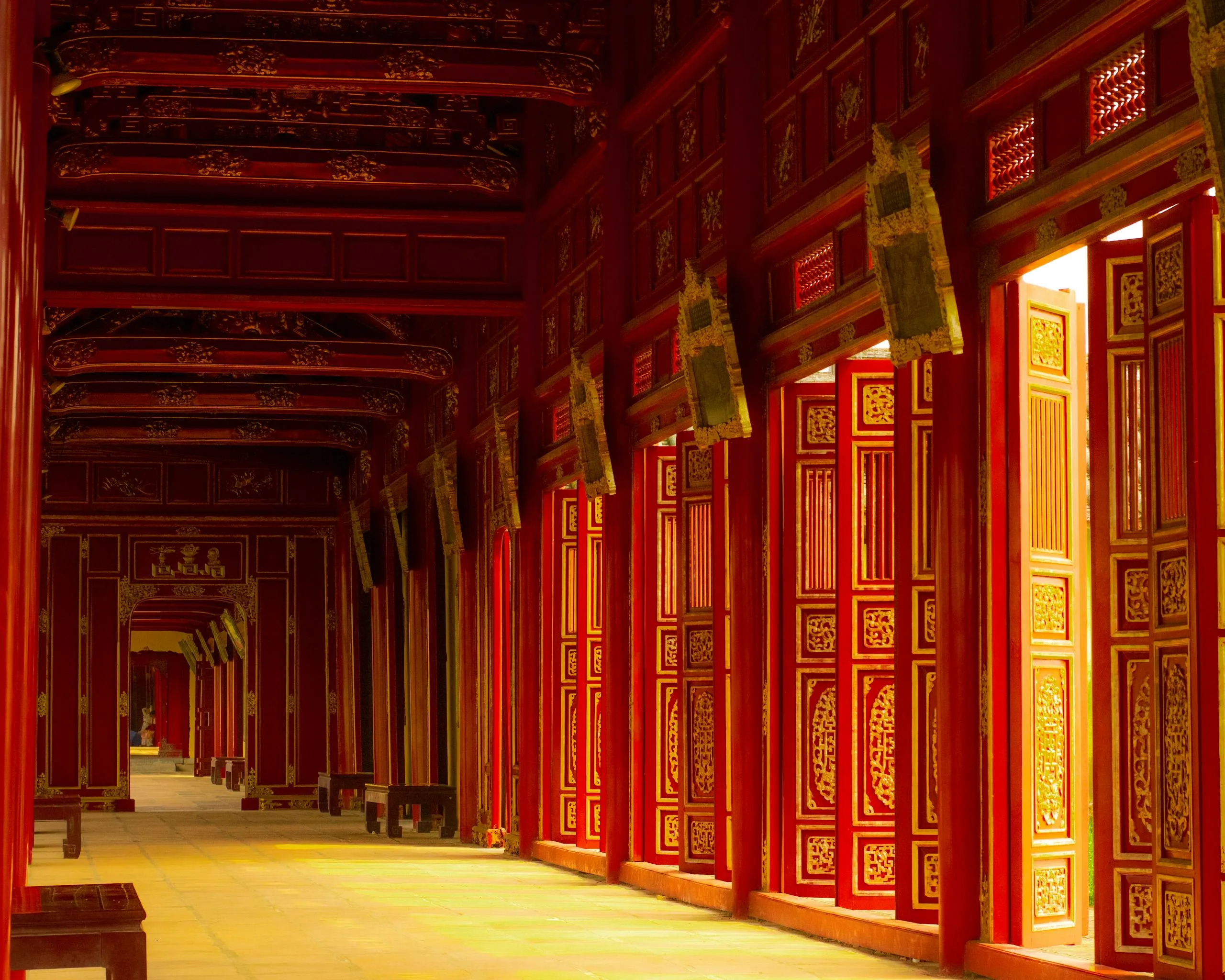
Getting Around: Local Transport Options and Accessibility
Want to really soak it all in? Using local transport adds to the experience. Walking around the city center is nice and easy, especially near the Imperial City and along the Perfume River, where it’s mostly flat. For a slower, charming pace, hop on a classic cyclo (rickshaw) and cruise past the sights.
If you’re up for some adventure, rent a bike to explore peaceful country lanes like the route to Thanh Toan Bridge. Motorbike taxis (Xe Om) are a cheap and quick way to get to royal tombs or sites outside downtown. For more comfort or longer trips, you can easily grab taxis or use apps like Grab. And hey—don’t miss a dragon boat ride on the Perfume River for a scenic, culturally rich trip to places like Thien Mu Pagoda.
Accessibility heads-up: Most big attractions are reachable by car or taxi, and have pretty wide paths, but some tombs and temples have stairs or uneven ground that might be tricky for folks with mobility limits.
Recommended Cultural Tours and Guided Experiences
A good guide makes a world of difference. Popular full-day Hue City Tours usually cover the Imperial Citadel, Thien Mu Pagoda, a Perfume River boat trip, and royal tombs like Tu Duc or Khai Dinh—with a tasty traditional lunch thrown in. Foodies might dig guided royal cuisine tours or cooking classes featuring iconic dishes like Bún bò Huế and bánh bèo.
For a more laid-back vibe, countryside bike tours take you to craft villages and rice paddies. Private car or motorbike tours offer flexible schedules, which work great for families or travelers who like to roll at their own pace.
Accommodation Mini-Guides Near Cultural Highlights
| Area | Pros | Recommended For | Example Properties* |
|---|---|---|---|
| Near Imperial City | Walking distance to the Citadel, museums, and riverside | First-time visitors, history buffs | Azerai La Residence, Emm Hotel Hue |
| Perfume River / Le Loi | Central spot, scenic views, close to nightlife | Couples, easy-going travelers | Saigon Morin Hotel, Moonlight Hotel Hue |
| Dong Ba Market Area | Near food markets, lively local atmosphere | Food lovers, budget travelers | Jade Scene Hotel Hue |
| Phu Cam / Tombs South | Quiet neighborhood near royal tombs and countryside | Returning visitors, long stays | Ana Mandara Hue Beach Resort (short drive away) |
*Pro tip: Always check recent reviews to make sure accessibility and amenities meet your needs before booking.
Planning Your Itinerary: Sample 1-Day and 3-Day Plans
Sample 1-Day Itinerary
- Morning: Start early at the Imperial City for a quieter vibe. Spend 2–3 hours exploring with an audio guide or tour.
- Late morning: Take a stroll or cyclo ride to Dong Ba Market to soak up local food and culture.
- Lunch: Treat yourself to royal dishes like Bún bò Huế or bánh khoái at a traditional spot.
- Afternoon: Enjoy a dragon boat cruise along the Perfume River to Thien Mu Pagoda, then wander riverside gardens.
- Optional: If time allows, visit an imperial tomb like Khai Dinh or Tu Duc by taxi or Grab.
Sample 3-Day Itinerary
- Day 1: Explore the Imperial City, Dong Ba Market, and enjoy a river cruise to Thien Mu Pagoda. End with a royal cuisine dinner.
- Day 2: Visit royal tombs—Minh Mang, Khai Dinh, and Tu Duc—with a knowledgeable guide. Cycle or taxi to Thanh Toan Bridge and craft villages, optionally hitting Tu Hieu Pagoda.
- Day 3: Join a cooking class or food tour, browse markets and a craft village, then relax at a riverside café as the sun sets.
Extra tips: Start early to beat crowds and heat. Pack rain gear if visiting between October and February. Bring small cash bills for tickets. Dress respectfully when visiting temples, and a translation app or phrasebook helps with chats.
FAQs and Insider Tips from Hue Residents
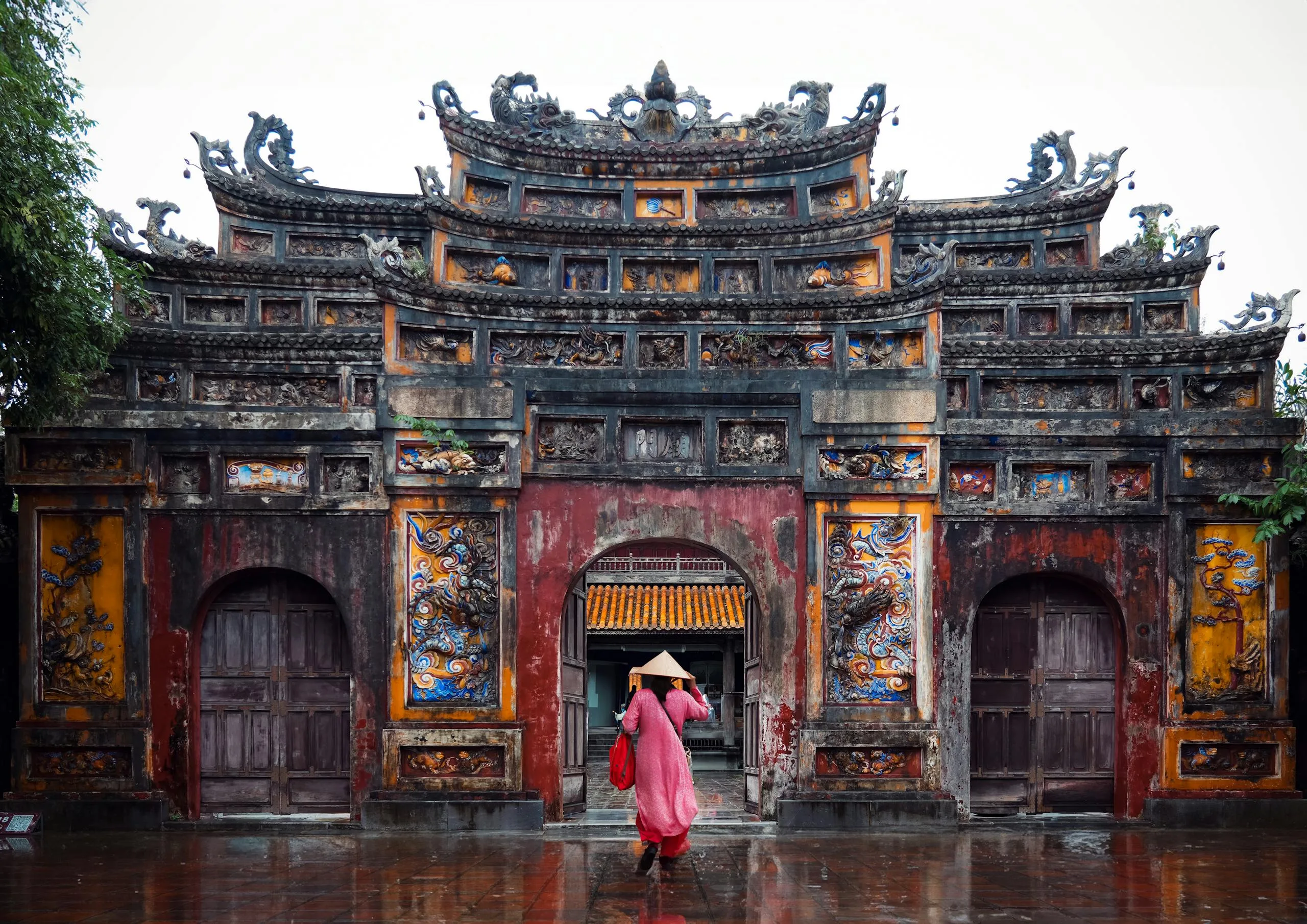
Common Visitor Questions Answered
People often ask about the best festivals, local foods, and cultural do’s and don’ts.
One beloved local festival is the Hon Chen Temple Festival, famous for its lively river procession honoring the Holy Mother Thien Ya Na. And of course, Tet—the Lunar New Year—is a big deal here, with ancestor worship, family gatherings, and lion dances.
Don’t miss the Nha Nhac royal court music, a UNESCO-listed tradition locals hold dear.135
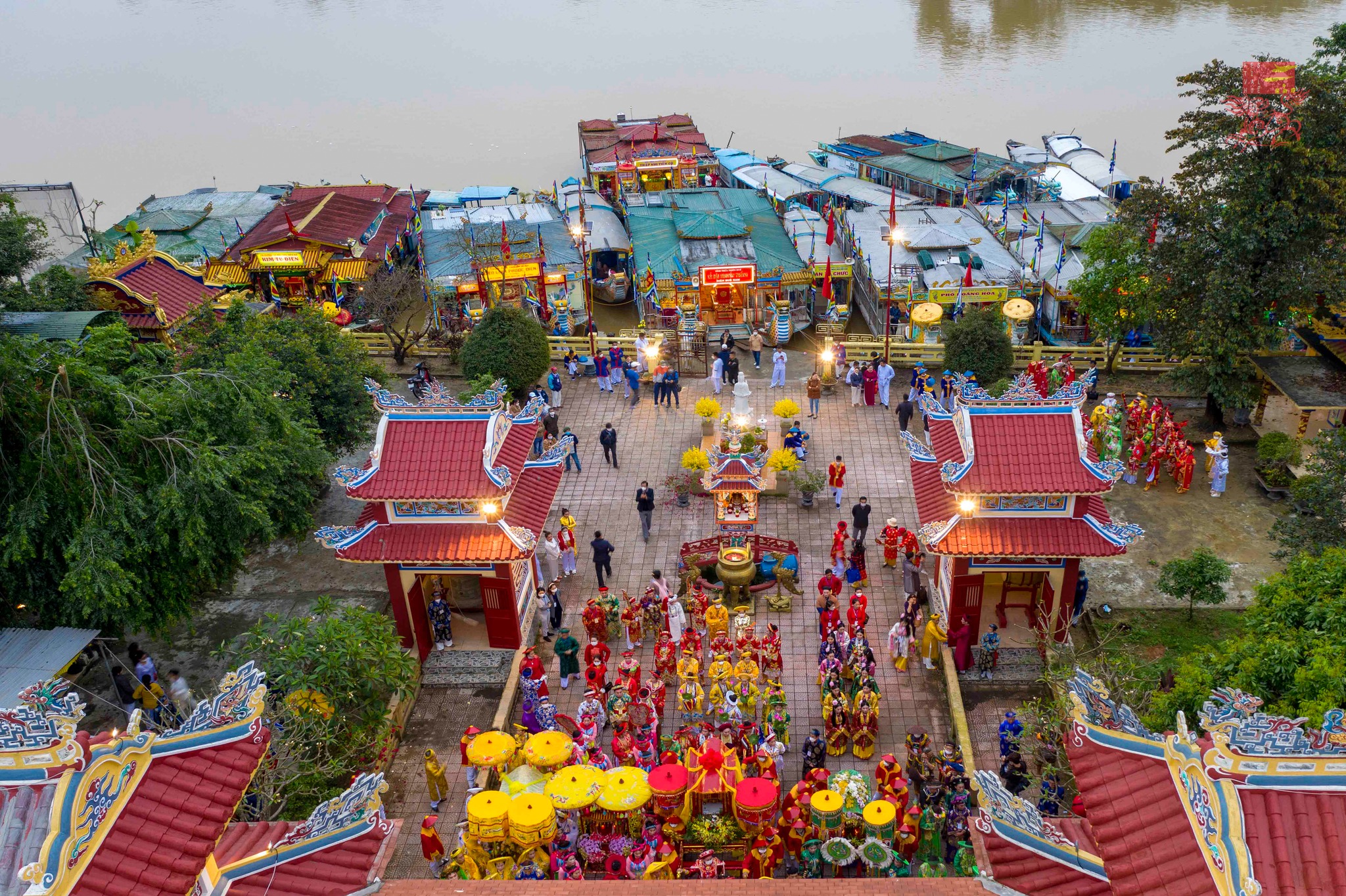
As for food, locals take pride in their refined noodle soups and street dishes rooted in royal history. Sharing a meal is more than eating—it’s about swapping stories and connecting with culture.15
Local Insights and Personal Stories
People from Hue often talk about their city’s calm dignity and close family ties.
Stories usually involve visits to pagodas, village festivals, and ancestor worship rituals at home—moments full of history and respect. Locals are generally welcoming if you show genuine interest in their customs and are eager to share their rich cultural knowledge.15
Artists in Hue emphasize the city’s blend of poetry, silk painting, and refined arts as expressions of its imperial spirit. And hey, sharing a bowl of noodle soup while swapping family stories? That’s a tradition worth experiencing.1
How to Respect Cultural Norms and Traditions
Greeting: A small bow or nod shows respect to elders. Use polite titles and language.1
Dress and Behavior: Dress modestly when visiting temples and always take your shoes off before entering homes or sacred spaces—it shows respect.2
Photography: Always ask before snapping photos of people, ceremonies, or altars to honor privacy and beliefs.2
Participating in Rituals: Watch respectfully before joining temple activities. Follow the lead on standing, bowing, and incense offerings. If offered food or drink, accept with both hands—it’s a sign of gratitude.1
Dos and Don’ts:
- Do learn some Vietnamese phrases, be patient, and show thanks.
- Do join community events if invited—it deepens your cultural experience.
- Don’t interrupt ceremonies, point at sacred things, or raise your voice in temples.
- Don’t disrespect ancestor altars or sacred objects.
Pro tip: A local once said, “Walking through Hue is like moving through layers of history woven into daily life. Visitors who listen and respect will find doors open to friendship and understanding.”1
Final Thoughts
Diving into cultural experiences in Hue is like stepping into a rich, ongoing story of Vietnam’s imperial past and vibrant present.
From wandering the majestic Imperial City and peaceful royal tombs to tasting exquisite royal dishes, exploring craft villages, and drifting along the Perfume River, every moment invites you to connect deeply with Hue’s unique heritage.
Add local festivals, museums, and bustling markets, and you’ve got an immersive adventure that’ll stick with you long after you leave.
To get the most out of your trip, jump into hands-on activities and guided tours that uncover the stories behind Hue’s treasures. Plan ahead, respect the local vibes, and take time to soak in the timeless beauty and warm hospitality this cultural gem offers.
Traveling through Hue means becoming part of a living narrative—where history, flavor, and tradition come together in unforgettable ways.
So, why wait?
Start planning your journey today and uncover all the layers of this amazing city.
- Key Takeaways
- Exploring Hue's Imperial Heritage
- Savoring Royal Cuisine and Traditional Foods
- Traditional Craft Villages: Hands-On Cultural Immersion
- Perfume River Activities and Scenic Boat Rides
- Festivals and Local Ceremonies: Engaging with Hue's Living Traditions
- Museums and Cultural Centers for Deepening Understanding
- Practical Travel Tips for an Authentic Hue Experience
- FAQs and Insider Tips from Hue Residents
- Final Thoughts
Get your FREE Monstera Art download
Join our WanderLife Studios mailing list to get updates about our work and be the first to know about upcoming art products.
As a Thank You Gift, you will get this wonderful hand-drawn Monstera Line Art as a digital download for FREE .


